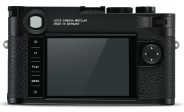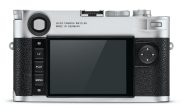Announced
Production status
System
Leica M system cameras
- Leica M (Typ 240)
- Leica M (Typ 262)
- Leica M Monochrom
- Leica M Monochrom (Typ 246)
- Leica M-A (Typ 127)
- Leica M-D (Typ 262)
- Leica M-E (Typ 220)
- Leica M-E (Typ 240)
- Leica M-P (Typ 240)
- Leica M1
- Leica M10
- Leica M10 Monochrom
- Leica M10-D
- Leica M10-P
- Leica M10-R
- Leica M11
- Leica M11 Monochrom
- Leica M11-P
- Leica M2
- Leica M3
- Leica M4
- Leica M4-2
- Leica M4-P
- Leica M5
- Leica M6
- Leica M6 (Typ 2248)
- Leica M6 Panda
- Leica M6 Titanium
- Leica M6 TTL
- Leica M6J
- Leica M7
- Leica M8
- Leica M8.2
- Leica M9
- Leica M9-P
- Leica MD
- Leica MD-2
- Leica MDa
- Leica MP
- Leica MP Original
Leica M10
35mm MF digital rangefinder camera • Discontinued
Specification
| Format: | |
| 35mm full frame | |
Imaging sensor: | 36 × 24mm CMOS sensor |
Resolution: | 5976 × 3984 - 24 MP |
Sensor-shift image stabilization: | - |
| Leica M [27.8mm] | |
| Shutter: | |
Type: | Focal-plane |
Model: | Electronically controlled |
Speeds: | 8 - 1/4000 + B |
| Exposure: | |
Exposure metering: | Through-the-lens (TTL), stop-down |
Exposure modes: | Aperture-priority Auto |
| Manual | |
| Rangefinder and Viewfinder: | |
Rangefinder: | Built-in, combined with viewfinder |
Viewfinder: | Built-in, combined with rangefinder |
Finder magnification: | 0.73x |
Actual rangefinder base: | 69.31mm |
Effective rangefinder base: | 50.6mm |
Bright-line frames: | 35mm & 135mm, 28mm & 90mm, 50mm & 75mm |
Parallax compensation: | Yes |
| Physical characteristics: | |
Weight: | 660g |
Dimensions: | 139x80x38.5mm |
| Accessories: | |
Body cap: | 14195 |
| 14397 |
Manufacturer description #1
January 18, 2017 - The iconic camera system sets new standards yet again. The perfect balance of long-established traditions and the latest technical innovation, the Leica M10 embodies the essence of photography like no other camera before. All of its functions have been adapted and updated to meet the precise needs of contemporary photography, while preserving the essential principles of the legendary M-System. Every single component and every technical feature concentrates uncompromisingly on this goal. With its more compact dimensions, improved performance and even more intuitive handling, the Leica M10 sets a new milestone in the ongoing history of Leica M photography.
The form factor: analog dimensions enter the digital age
Many photographers who appreciate the dimensions of analog M-Models, due to their ideal ergonomics and perfect fit in hand, expressed wishes that this carry over to digital M-Cameras. Leica has now brought these dream dimensions to reality – with a top plate depth of only 33.75 millimeters, a whole four millimeters (1/8”) thinner than that of its predecessor, the Leica M (Typ 240). The Leica M10 is now the slimmest digital M of all time.
The rangefinder: a precise window on the world
The rangefinder has always played an extremely important role in the storied heritage of the Leica M-System. A number of important aspects of this legendary focusing technology have now been further optimized in the Leica M10. To improve the view of the subject, the field of view has been enlarged by 30 percent and the magnification factor has been increased to 0.73x. Eye-relief – the optimum distance of the eye from the viewfinder eyepiece – has also been considerably increased. Thanks to a 50 percent increase in this distance, the viewfinder is much more comfortable to use, particularly for photographers who wear glasses.
The sensor: the digital canvas
The key component of the Leica M10 is the all-new 24 MP, full-frame CMOS sensor developed specifically for this camera. Its new technology leads to significant improvements in all parameters relevant to imaging performance: impressive dynamic range, excellent contrast rendition, exceptional sharpness and the finest resolution of details. Its unique pixel and microlens architecture enables optimum results at all apertures, particularly wide open – even rays of light arriving at the sensor from oblique angles are precisely captured by its photodiodes – further improved in comparison to the previous generation. The glass cover plate of the sensor acts as an infrared cut-off filter and thus also avoids undesirable refraction of incoming light by additional layers of glass. The omission of a low-pass filter also ensures that the Leica M10 delivers maximum sharpness. This leads to significantly better imaging results, especially in the case of wide-angles and fast-aperture lenses.
Thanks to the new design of the sensor of the Leica M10, the ISO sensitivity range has been expanded. It now allows exposures at values between ISO 100 and 50,000 with considerably improved noise characteristics at higher ISO settings. The Leica M10 opens up new areas of photography and delivers exceptional imaging performance even in difficult lighting conditions.
Image processing electronics: the next level of quality
The latest-generation Maestro II image processor of the M10 showcases state-of-the-art advanced processor technology. In combination with the equally new 24 MP sensor, this ensures that all exposures captured stand out with exceptionally brilliant image quality. Thanks to a 2 GB buffer memory and continuous burst shooting at up to five frames per second at full resolution, photographers will never again miss the decisive moment. The Leica M10 is the fastest M-Camera ever made.
In addition to this, the faster processor allows the loupe function in Live View mode to be freely positioned anywhere in the frame for even better assessment of sharpness. This new function can be used not only on the camera’s LCD monitor, but also in conjunction with the Visoflex electronic viewfinder (EVF) with 2.4 MP of resolution. The viewfinder features a swivel function for shooting from unusual angles and an integrated GPS module that can be switched on for geotagging image files.
The operating concept: intuitive and reduced to essentials
Since the beginning, Leica M-Cameras have stood for concentration on essential functions. This principle has been conscientiously pursued in the Leica M10, which sets new standards in terms of intuitive handling and rapid access to the settings relevant to photography. For instance, the controls on the back are limited to the directional control and just three buttons for Play, Live View and Menu. The importance of particular settings varies according to personal preferences and photographic needs. In light of this, the Leica M10 also offers a freely configurable Favorites Menu for defining a custom profile of personally relevant functions.
One of the most distinctive new features of the Leica M10 is the ISO setting dial on the top plate. For the first time in a digital Leica M, all essential shooting parameters such as focusing, aperture, shutter speed and ISO value can be selected manually without using the menu – or even switching on the camera. This concept allows for the fastest, most precise control yet seen in a digital camera and enables the photographer to be even less obtrusive when shooting.
The Wi-Fi module: memories are there to be shared and shown
The Leica M10 is the first M-Camera with integrated Wi-Fi connectivity. This enables fast, wireless transfer of pictures to Apple mobile devices (with Android shortly to follow), where they can be edited and, for instance, posted and shared on social networks. The Leica M-App also enables the direct transfer of RAW files in DNG format to mobile devices for further processing with suitable apps from iOS Version 10.2. The Leica M10 can also be remotely controlled via Wi-Fi from a smartphone or tablet. This makes it easy to shoot perfect pictures from unusual angles or avoid camera shake when shooting with longer shutter speeds.
Leica M10: A further step towards perfection
“The Leica M is the heart, the backbone and the soul of Leica Camera. The Leica M10 unites state-of-the-art technology and exceptional optical performance with a conscious focus on the traditional advantages of the unique Leica M rangefinder system. In this, the innovative camera and its concentration on the functions essential to photography set new standards, while its exceptionally lean handling concept takes us a further step towards absolute perfection. Made in Germany by Leica – the Leica M10 stands as an outstanding brand statement for the finest arts of engineering, highest quality and craftsmanship,” explained Oliver Kaltner, CEO, Leica Camera.
“The new M, the M10! Not a camera for everyone – but increasingly a camera for people who love a system that is built for the future while maintaining consistent compatibility with its past. The rangefinder system lets me frame and compose my pictures. The rangefinder system lets me tread in the footsteps of the world’s greatest photographers. The rangefinder system lets me create photographs with my own visual style. The new M10 and the wealth of present and past Leica M-Lenses are products that awaken and fulfil the desires of every photographer,” emphasized Dr. Andreas Kaufmann, majority shareholder and chairman of the supervisory board of Leica Camera.
Manufacturer description #2
Its unique balance of heritage and technical innovation embodies the essence of everything that is truly important for photography.
Compact dimensions, improved performance and the new ISO setting dial on the top plate offer M-Photographers what they wish for from an M-Camera.
Since the release of the Leica M3 at Photokina in 1954, every single M-System camera has represented the pinnacle of innovation for its day. Defined by what is essential for photography. Leica embodies this passion for quality, craftsmanship and its philosophy of photography until today. More than 60 years of rangefinder expertise, 11 years of digital M-Camera development and invaluable feedback from dedicated M-Photographers have inspired Leica engineers to create the slimmest digital M of all time: the Leica M10.
Many photographers appreciate the dimensions of analogue M-Camera models for their perfect ergonomics and their fit in the hands. The Leica M10 marks the return to precisely these dimensions.
The ISO setting dial allows photographers to set the most important parameters for any particular situation– even when the camera is switched off.
Thanks to the new sensor design of the Leica M10, the ISO sensitivity range has now been extended to enable exposures between ISO 100 and ISO 50,000.
The focus has been set on the functions essential for photography: The back of the camera features only three buttons: Review, Live-View and Menu.
To improve the view of the subject, the field of view has been enlarged by 30% and the magnification factor has been increased 0.73. In addition to this, the eye-relief distance has also been significantly increased.
Thanks to a 2 GB buffer memory and sequential shooting at up to five frames per second, photographers will never again miss the decisive moment.
Manufacturer description #3
Many photographers wished for a return to the dimensions and ideal ergonomics of analogue M models. Leica has taken note of these wishes: the dimensions of the M10 are now identical to those of analogue M-Cameras. The Leica M10 is the slimmest digital M of all time.
The new sensor design of the Leica M10 has made it possible to extend the ISO sensitivity range to values between 100 and 50,000 and also brings significantly improved noise characteristics in exposures captured at higher ISO values. The Leica M10 opens up entirely new areas of photography and delivers exceptional imaging performance even in difficult lighting conditions.
One of the most striking changes in the case of the Leica M10 is the ISO setting dial on the top plate. For the first time in a digital M, the M10 allows all essential shooting parameters such as distance, aperture, exposure time and ISO values to be preselected without using the menu – or even switching on the camera. For even better control and even more discreet photography.
With a handling concept reduced to the currently achievable minimum, the Leica M10 takes a further step in the direction of absolute perfection. Every single component and every technical solution in the Leica M10 concentrates uncompromisingly on photography. For instance, there are only three buttons on the back of the camera: Review, Live-View and Menu.
From the very beginning, the ‘Messsucher’ (combined rangefinder/viewfinder) of the Leica M played an essential role. So essential that it gave the system its name; the ‘M‘ stands for ‘Messsucher’. For the Leica M10, several important aspects of this legendary combined viewfinder and rangefinder system have now been further improved. To improve the view of the subject, the field of view has been enlarged by 30% and the magnification factor has been increased 0.73. In addition to this, the eye-relief distance has also been significantly increased. Thanks to a 50% increase in this distance, the viewfinder is much more convenient to use, particularly for photographers who wear glasses.
Thanks to a 2 GB buffer memory and sequential shooting at up to five frames per second at full resolution, photographers will never again miss the decisive moment.
The latest-generation Leica Maestro-II image processor of the Leica M10 reflects the state-of-the-art of advanced processor technology. In combination with the new 24 MP sensor, this ensures that all exposures fulfil the promise made by Leica: pictures that captivate with exceptional quality and brilliance. As a result, the Leica M10 delivers images with low digital noise levels and true-to-life detail, even at ISO values as high as 50,000.
The key component of the Leica M10 is the 24 MP, full-frame CMOS sensor developed especially for the camera. It features new technologies that lead to significant improvements in all parameters relevant to imaging performance: impressive dynamic range, excellent contrast rendition, exceptional sharpness and finest resolution of details.
Thanks to components machined from solid brass, the high strength of the M-10’s full-metal, magnesium alloy chassis and scratch-resistant Corning® Gorilla® Glass, is built to effortlessly resist the adversities of everyday life guaranteeing enduring pleasure to the photographers. Further protection against light showers, dust and bad weather is provided by special rubber seals.
The importance of particular settings varies according to personal preferences and photographic needs. To cater for these, the Leica M10 offers a programmable ‘Favourites’ menu. In this menu, the photographer defines personal preferences for the relevant parameters and can later access them at the press of a button. The settings can be easily changed
The Leica M10 is the first M-Camera with an integrated WLAN module. This allows pictures to be sent conveniently to iOS devices wireless and shared online. It also enables remote control of the Leica M10 by WLAN with a smartphone and Leica FOTOS. If required, important parameters like the shutter speed or functions like releasing the shutter can also be controlled from the smartphone. This makes it easy to shoot from unusual angles and avoid camera shake when shooting with longer shutter speeds.
Focusing made easy: The Live View function of the Leica M10 offers two convenient focusing method. Focus Peaking automatically marks sharply focused edges as coloured lines and Live View offers the ability to magnify the subject on the monitor screen. In the Leica M10, the visibility of these contrasting lines has been improved against the previous generation and now enables even more convenient focusing assessment to ensure images with outstanding sharpness.
Leica has been making history for decades – with cameras that have always been ahead of their times. Throughout all these years, Leica has always kept a tight focus on sustainability. In the 1950s, Leica created a timeless and enduring standard – the Leica M-Bayonet: almost all M-Lenses produced ever since can be mounted and used on today’s Leica M10. Our optical instruments are timeless and faithful companions with enduring reliability and an exceptionally long life.
Special editions (4)
- Leica M10 "Edition Zagato" (250 units) - June 2018
- Leica M10 "Leitzpark Edition" (100 units) - June 2018
- Leica M10 "Robb Report 15 Years Russian Edition" (15 units) - December 2019
- Leica M10 "Royal Selangor" (20 units) - December 2018






